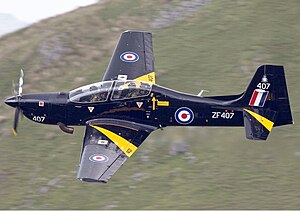|
Short Tucano
The Short Tucano is a two-seat turboprop basic trainer built by Short Brothers in Belfast, Northern Ireland. It is a licence-built version of the Brazilian Embraer EMB 312 Tucano. On 14 February 1986, the prototype conducted its maiden flight in Brazil before being delivered to Shorts to be used as a pattern aircraft and modified to meet Royal Air Force (RAF) requirements and used for trials and demonstrations. The first Short-assembled aircraft flew on 30 December 1986; deliveries to the RAF commenced during June 1988. The final example of the type was completed in 1995. Maintenance and support of the RAF's Tucano fleet was typically outsourced to several private companies. The RAF was the Tucano's primary operator, although export sales have been achieved with the nations of Kenya and Kuwait. A handful have also been purchased and piloted by private individuals. On 25 October 2019, the Tucano was withdrawn from RAF service and was replaced by the Beechcraft T-6Cs. Design and developmentOriginsDevelopment of the Short Tucano commenced in May 1984, following an agreement between Brazilian aircraft manufacturer Embraer and Northern Ireland aviation firm Short Brothers to collaborate on a response to an outstanding British requirement, which sought a replacement for the aging BAC Jet Provost basic trainer for the Royal Air Force (RAF).[1] For this purpose, the RAF had issued Air Staff Target 412, defining the performance criteria it desired for a new high-performance turboprop-powered basic trainer. A short list was compiled of various aircraft that had been submitted in response; other than the Tucano, the types considered were the Swiss Pilatus PC-9, the British NDN-1T Turbo-Firecracker and the Australian Aircraft Consortium's (AAC) A.20 Wamira II.[1] During 1984, Embraer dispatched the seventh EMB-312 airframe off the production line to Shorts, where it received numerous modifications in order to meet the AST-412 requirements.[1] During September 1984, this same aircraft was displayed at the Farnborough Airshow; by this point, it had been equipped with an uprated PT6A-25C2 engine and a ventral air brake, which reportedly enabled the Tucano to achieve the required stall speed of 60 kn.[1] However, tests undertaken at MOD Boscombe Down later on that year indicated the need to re-engine the aircraft in order to satisfy the RAF's requirement for time to height; accordingly, the Garrett TPE331 was selected.[1] On 21 March 1985, the Short Tucano proposal was declared the winner of the AST.412, receiving a contract worth £126 million for the provision of 130 aircraft, along with an option for a further 15;[1] this option was never taken up. The first flight of the prototype EMB-312G2, which was furnished with a four-bladed Hartzell propeller and the Garrett TPE331-10 engine, took place in Brazil on 14 February of the following year. Shortly afterwards, this aircraft was disassembled and airlifted to Short's Belfast facility on 29 March 1986, where it was reassembled and returned to the skies just ten days later.[2] During June of that year, the TPE331-10 engine was replaced by the improved TPE331-12B, with a major difference being the integration of an Electronic Engine Controller (EEC) system.[1][2] Production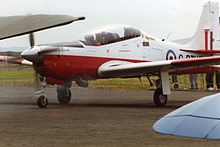 On 30 December 1986, the first standard production model Tucano T.Mk 1 was flown; its official rollout took place on 20 January 1987.[3] On 10 March 1987, the second aircraft made its first flight, and, by April, a third Tucano had joined the test fleet for clearance and final testing, which was largely undertaken at MOD Boscombe Down.[4] The fourth aircraft to be built was the first delivered to the RAF on 16 June 1988 at the Central Flying School.[5] Deliveries would continue to the RAF for another five years, the final aircraft arriving on 25 January 1993.[6] In addition to the sizable order for the RAF, multiple export customers emerged for the Shorts-produced Tucanos. The Kenyan Air Force ordered a total of 12 units while a further 16 Tucanos were exported to Kuwait. Those Tucanos delivered to the Kuwait Air Force were suitable furnished to be combat-capable; they were armed for the purposes of both weapons training and light attack duties; such aircraft are fitted with four hard points, each capable of mounting various rocket pods, cannons, bombs, and external fuel tanks.[7] Due to its Garrett engine, the Short Tucano is more responsive to thrust changes and is somewhat noisier than the original Tucano.[8] In addition to the revised engine, the major differences of the Short Tucano are a strengthened airframe for an improved fatigue life, a cockpit layout similar to the RAF's Hawk advanced trainer, a revised oxygen system, a flight data recorder, a four-bladed propeller, ventral airbrake and restyled wingtips. Two Martin-Baker MB 8LC ejection seats are used and the canopy was modified to meet the RAF's bird strike requirements. During its production run, Shorts commonly promoted the airframe as being "100% British-built".[9] In order to meet RAF requirements, the EMB-312 has some 900 modifications, which reduces its commonality with the original aircraft to roughly 50% of its content.[10] Operational history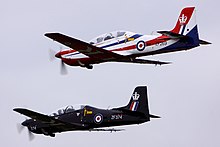 During June 1988, the first Tucano deliveries were made to the RAF; induction of the type commenced thereafter. The type has been principally operated by No. 1 Flying Training School, based at RAF Linton-on-Ouse, where it has been used to provide basic fast-jet flying training to RAF and RN student pilots, on 72 (Reserve) Squadron.[11] Typically, student pilots would fly around 130 hours during their training course on the Tucano before progressing to the jet-powered Hawk T2 aircraft, based at RAF Valley.[11]
House of Commons debate, October 2007.[12]
The Short Tucano succeeded the BAC Jet Provost as the basic trainer for the RAF, preparing the student pilots for progression to the Hawk T1 advanced trainer aircraft. Following its introduction, the Tucano had reportedly proven to be roughly 70% cheaper to operate than its predecessor.[13] The Tucano's accident record has also been remarkably better than other ab-initio training aircraft, with only five aircraft written off with no fatalities in over 20 years.[14] In March 2007, while discussing the British military contribution to the War in Afghanistan, the British Parliament discussed the concept of replacing the region's detachment of RAF Harriers and Tornados, which were being used to provide close air support to Allied forces, with a number of armed Short Tucanos, which would be re-roled as a dedicated counter-insurgency asset.[15] Such use would have required extensive modifications to the RAF aircraft, as they were not fitted with underwing hard points for mounting armaments and equipment upon. Air Chief Marshal Stephen Dalton was dismissive of this suggested use of the Tucano, stating that it would cost lives amongst those on the ground and damage Britain's credibility and influence within the coalition forces in Afghanistan, and criticising its lack of operational flexibility.[15] The RAF's Tucanos have been typically maintained by private companies, defence firm VT Group operated one such support contract during the early 2010s.[16] During July 2008, the Tucano's envisioned retirement date was moved from 2010 to around 2012, although further extension seemed likely.[17] At one point, Marshall Aerospace were championing the concept of upgrading the Tucano fleet as an inexpensive means of meeting the RAF's future basic trainer requirements; the prospective upgrade would have been largely based around cockpit instrumentation improvements as the airframes reportedly had around 8,000 flying hours remaining; some aerodynamic refinements had also been mooted but were dismissed as not being cost-effective.[18] By 2010, the Tucano fleet was scheduled to be withdrawn from RAF service in 2015, at which point it was to have been replaced by the winner of the UK Military Flying Training System (UKMFTS) programme.[16] However, the type's out of service date was put back by several years; the last of the Beechcraft T-6Cs, the Tucano's direct replacement, was delivered to RAF Valley on 3 December 2018.[19][20] On 25 October 2019, the Tucano was withdrawn from RAF service; to mark the type's retirement, an aerial display was performed at RAF Linton-on-Ouse, North Yorkshire, which was also set for closure.[21][22] Accidents and incidentsOn 22 Feb 1990, the first export Tucano Mk 51 ZH203 (destined for Kenya) crashed near Rathlin Island due to tailplane flutter in high speed weapons carriage trials, killing Shorts Chief Test Pilot Allan Deacon who ejected but drowned.[23] The RAF lost 5 aircraft in service, all non-fatal (four involved ejections): ZF316 on 12 May 1992,[24] ZF270 on 13 May 1996,[25] ZF293 on 22 Aug 2000,[26] ZF344 on 12 Mar 2009[27] and ZF349 on 8 Jan 2013.[28] On 22 June 2015, movie soundtrack composer James Horner died when the Tucano he was piloting crashed in central California in a remote region of the Los Padres National Forest about 60 miles (97 km) north of Santa Barbara. Horner was the sole occupant of the plane.[29][30][31] Variants
Operators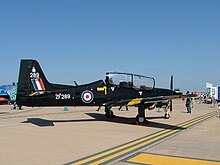
Former operators
Specifications (Tucano)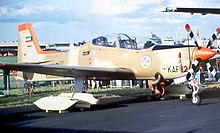  Data from Jane's All the World's Aircraft, 1988–1989 [38] and Tucano T Mk 1 Aircrew Manual, 2015 [39] General characteristics
Performance
Armament
See alsoRelated development Aircraft of comparable role, configuration, and era Related lists ReferencesCitations
Bibliography
External linksWikimedia Commons has media related to Short Tucano. |
||||||||||||||||||||||||||||||
Portal di Ensiklopedia Dunia
